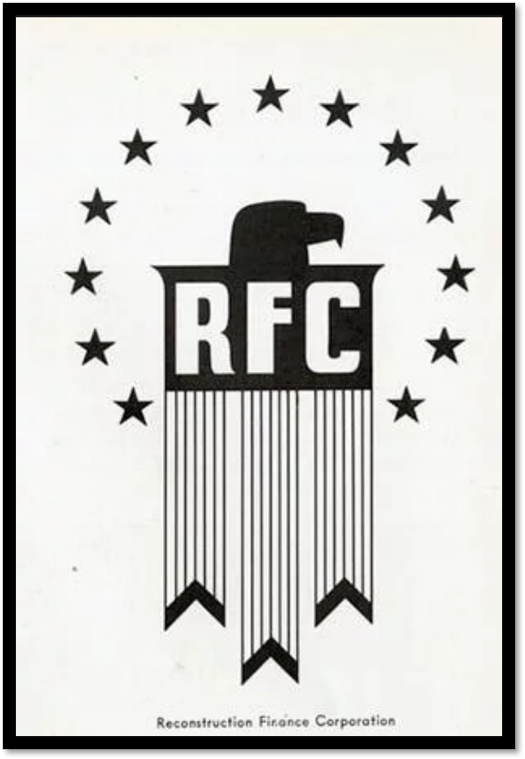
The New Deal and Recovery, Part 24: The RFC
(In writing this series, I allowed myself to skip over some topics. But now that I’m turning the series into a book, to be published by the University of Chicago Press, I have to close those gaps. The most important gap by far concerns the Reconstruction Finance Corporation. Although the RFC was originally established by Herbert Hoover, the Roosevelt administration not only allowed it to survive but turned it into the largest and most powerful of all New Deal agencies. Hence a three-part essay, of which this is the first installment.)
Hoover’s New Deal
There are few more successful examples in history of the propaganda technique known as the “big lie” than the charge that Herbert Hoover was a “do nothing” president. In fact, Hoover was being perfectly truthful when, in the course of the ’32 campaign, he said. “We might have done nothing. … Instead, we met the situation with … the most gigantic programs of economic defense and counterattack ever evolved in the history of the Republic.” So, for that matter, was his opponent, who accused the Hoover administration “of being the greatest spending administration in all our history” (Lyons 1948, 287). On public works alone, the Hoover administration spent more than the previous nine administrations combined, notwithstanding that their undertakings included the Panama Canal (ibid., 269). No previous administration, David Kennedy (1999, p. 48) observes, ever “moved so purposefully and so creatively in the face of an economic downturn.”
The centerpiece of the “Hoover New Deal”—the Reconstruction Finance Corporation (RFC)—went on to play an even more important role in the Roosevelt version. Under the leadership of Texas entrepreneur Jesse H. Jones, it became nothing less than “America’s largest corporation and the world’s biggest and most varied banking organization” (Jones 1951, 3).[1]
But did it help the U.S. economy recover from the Great Depression?
A Shadow Fed
Although Hoover ultimately supported it, credit for the RFC’s establishment is mostly due to Eugene Meyer, a staunch Republican whom Hoover made governor of the Federal Reserve Board in 1930. Between 1918 and 1925 Meyer served as managing director of the War Finance Corporation (WFC), the original goals of which were making cheap credit available to firms producing war materials and propping up the price of Liberty Bonds. After the war, Meyer kept the WFC alive by converting it into an agricultural credit agency. But Meyer stepped down in 1925, and the WFC quit extending credit of any sort, though it didn’t officially close until it finished collecting on its debts 14 years later.
As bank failures mounted after 1930, Meyer, in his new post as head of the Federal Reserve Board, pushed hard both for a relaxation of the Fed’s own credit eligibility requirements and for the WFC’s revival. But Hoover favored a private and voluntary alternative, so Meyer instead tried to get bankers to cooperate toward that end. Thanks to Great Britain’s suspension of the gold standard on September 18, 1931, which led to large-scale withdrawals of gold from the United States banking system, and that many more bank failures, he finally succeeded.
The result, announced by Hoover in the wee hours of October 7th, was the National Credit Corporation (NCC), a half-billion-dollar private credit pool to be established and run by bankers and insurance executives. Because the NCC was prepared to rediscount bank assets the Fed wouldn’t accept, and could do so for financial institutions that weren’t Fed members, Hoover and the bankers hoped that the Fed and NCC between them could keep all the nation’s banks liquid enough to avoid suspending en masse. But Meyer himself was far from sanguine; and it was owing to his importuning, rather than to any enthusiasm for the idea on Hoover’s part, that Hoover agreed to declare, in announcing the NCC, that “if necessity requires, I will recommend the creation of a finance corporation similar in character and purpose to the War Finance Corporation, with available funds sufficient for any legitimate call in support of credit.[2]
Nor did it take long for the NCC’s inadequacy to show itself: it took a month just to open for business, and still longer to start making loans. By December it had lent only $10 million.[3] By then Meyer had a bill ready calling for a revived WFC, to be known as the “Reconstruction Finance Corporation.” Congress pushed the legislation through as quickly as it could, allowing for the holiday recess; and Hoover made a law of it on January 22, 1933. The new executive agency thus established began with a capital stock of $500 million subscribed by the Treasury, and was authorized to borrow three times that amount. Serving as its head was Chicago banker and former Vice President Charles G. Dawes.
Thrown for a Loop
As long as Dawes was in charge of it, the RFC’s lending was limited to financial institutions and railroads; and its precise remit, according to Hoover’s remarks upon signing it, was narrower still. “It is not created for the aid of big industries and big banks,” Hoover said. “Such institutions are amply able to take care of themselves. It is created for the support of smaller banks and financial institutions, through rendering their resources liquid, to give renewed support to business and agriculture.”
Yet just which banks the RFC had been helping during its first five months remained shrouded in mystery, for its quarterly reports only revealed the aggregate sums lent to various broad categories of borrowers, with nothing about particular loan recipients. In other words, as journalist John T. Flynn (1933) later complained, “it passed round hundreds of millions of dollars of public money to banks and railroads without affording either to the public, or even to Congress itself, a grain of information about the identity of the objects of its bounty.”
A change came following Chicago’s banking crisis. In early June 1932, Dawes abruptly resigned; days later, as he boarded a train to Chicago, he explained that he was heading there to take charge of the Central Republic Bank, of which he was still nominal chairman. Just over a week after he arrived, as the Democratic National Convention was about to convene in the Windy City, Dawes coolly informed a group including Chicago’s leading bankers and RFC board member Jesse Jones, that the Central Republic, which was one of several Loop banks that had been hemorrhaging money for weeks, wouldn’t open the next morning. Fearing a general collapse, Jones quickly arranged, with Hoover’s approval, to have the RFC lend it $90 million—by far its biggest loan yet—to allow it and the other Loop banks to open the next morning.
When word of the so-called “Dawes Loan” got out, accusations of favoritism went flying.[4] Congress’s response became part of the Emergency Relief and Construction act signed by Hoover on July 17th, 1932. On the plus side, this amendment to the RFC Act increased the RFC’s borrowing authority to $3.3 billion dollars, for use in supporting state and local relief agencies, public works programs, and various agricultural credit agencies, among other things. But the amendment also placed new limits on the RFC’s lending. It forbade loans to financial institutions whose officers or board members included anyone who sat on the RFC’s board, or had done so within a year prior to the date on which a loan was granted; and it called for the corporation to submit monthly reports on its activities, including borrowers’ names, to the Senate and House, or, if Congress wasn’t in session, to the Senate Secretary and House Clerk.
Bigger Isn’t Better
Although the publicity clause wasn’t made retroactive, Congress eventually asked the RFC to supply it with details concerning the loans it had made during its first five months, which it did on January 25th, 1933. It was then possible for Congress and the general public to see just how well the RFC had lived up to President Hoover’s claim that it wasn’t there to help big banks.
What they discovered was that, during the RFC’s first five months, the Central Republic was far from being the only big bank to receive its help. Although the corporation’s officers and champions, including Hoover himself, had technically been telling the truth when they repeatedly pointed out that “most of its loans” went to small banks, the claim obscured the fact that most of the RFC’s money went to relatively large ones. For example, after the corporation had been in business for five weeks, the White House declared that it had lent $61 million, most of which went to 255 “mostly small country banks.” What it didn’t say was that more than two-thirds of that amount went to just three banks, all located in fair-sized cities. During the whole of the RFC’s first five months, before its loan recipients’ names were routinely furnished to Congress, more than 40 percent of the $642 million of loans it had authorized went to banks in just seven good-size cities, with banks in Chicago and San Francisco alone receiving $136 million (Flynn 1933). Furthermore, many of the RFC’s loans to smaller banks were aimed at indirectly helping larger ones to which the smaller banks owed money.
Actually, there were good reasons for this record. The pattern of RFC lending to large banks was roughly consistent with the distribution of U.S. banks by size, and with the fact that, other things equal, bigger banks tended to lose more deposits than small ones. And, despite Hoover, some big banks, like Central Republic, were quite unable to “take care of themselves.” Finally, the failure of a big bank was more likely to cause other banks to fail. In fact, contemporary complaints notwithstanding, economic historians have not found much evidence that politics shaped the pattern of the RFC’s loans to banks (Mason 2003).
Even so, once it had to submit detailed monthly reports, the RFC quit making very large loans to very big banks. Indeed, it made fewer loans to banks of all sorts. Jesse Jones (1951, 83), who sat on the RFC’s board at this time, and later became its most famous chairman, believed that the publicity “prevented many bankers from applying for help that was sorely needed,” owing either to pride or to fear of having their banks stigmatized. Whatever the reason, it didn’t make the RFC’s job any easier.
Lent to Death
Of course the Hoover RFC didn’t keep the U.S. financial system safe from “unexpected shocks”; neither did it otherwise stop the U.S. economy’s downward spiral. “Perhaps it is too much,” Harvard’s Franklin Ebersole (1933, 484) observed, in reviewing its one-year record, “to expect the Corporation should have effected a cure for the crisis and depression. But the label ‘Reconstruction’ offered more than hope and mere salvage.” Unfortunately, although Hoover’s RFC authorized $951,000,000 in loans to open banks and trust companies, and another $200,000,000 to closed banks’ receivers, for distribution to their depositors, these amounts simply weren’t enough to either keep open banks liquid or pay off deposits at closed ones in full.
But did they at least help? “To criticize the Corporation for not keeping banks open or stimulating business recovery,” Ebersole (ibid., 486) says, “assumes a large objective—the maximum achievement.” But perhaps, he allows, it was only supposed to tide banks, railroads, state relief agencies, and farmers over until other steps could be taken. Alas, he concludes, “even for such a limited objective, it must be said…that [Hoover’s RFC] was a gamble that failed.” Charles Calomiris and his coauthors (2013, 528) go still further: they find, not merely the RFC’s loans were generally unhelpful, but that they seem to have made banks that took advantage of them worse off. Besides disqualifying many banks, the RFC’s strict collateral requirements also stripped those that secured loans from it of their best collateral. The fact that the Corporation had priority over banks’ other creditors gave better-informed depositors a reason to steer clear of banks that borrowed from it, and this in turn gave bankers a reason to think twice before asking for the RFC’s help. According to Joseph Mason (2001, 90), this problem was especially important before July 1932, when (owing largely to Eugene Meyer’s influence) the RFC’s collateral requirements were especially strict.
The verdicts of some other economists aren’t quite so severe. Ernest Klemme (1939, 366) and Berylt Sprinkel (1952, 218) maintain that the RFC’s loans reduced bank suspensions and bolstered depositor confidence until the Michigan banking crisis proved the last straw. James Butkiewicz (1995) finds that the RFC’s loans helped before it was compelled to publicize them, cutting bank suspensions “almost in half,” but that they made little difference afterward. Joseph Mason (2001, 89), on the other hand, finds “a positive significant relation between loan publicity and bank survival.” One explanation for such apparently contradictory findings is that the most vulnerable banks were also the ones that chose not to seek the RFC’s help once they could no longer have it confidentially.
Standing back from all of this research, the picture one takes in shows an RFC hampered in its efforts to keep the banking system liquid, but not always for the same reason. The corporation’s strict collateral requirements limited its success through July 1932, while banks’ fear of adverse publicity did so afterward. The result, either way, was that the RFC’s bank lending program failed to deliver the goods.
6000 Bailouts
Five days after FDR took office, with all of the nation’s banks closed and economic activity practically at a standstill, no one doubted that, considered as a recovery device, the RFC had been a flop. “Despite unprecedented efforts on behalf of the private economy,” James Stuart Olson (1982, p. 17) writes, “the RFC had not revived commercial credit, business investment, production, or employment.” The Roosevelt administration “was not even sure the RFC was really strengthening the banking system.”
So far as the nation’s banks were concerned, the fundamental problem, which became all too evident in the course of the national bank holiday, was no longer a lack of liquidity. They needed capital, and plenty of it: on mark-to-market terms, the U.S. banking system as a whole was broke (Kimmel 1939, 9). And the RFC was about to start giving it to them, by not just lending to them but buying their preferred stock shares, notes, and debentures. Although the RFC would still lend to banks after its share purchase program began, its loans would no longer have to keep struggling banks alive as their primary aim. Instead, they would mostly be used to assist in the liquidation of banks that died.[5]
Although the share purchase program was the first major New Deal addition to the RFC’s powers, several Fed officials had first proposed it in the wake of the Chicago banking crisis. Although Hoover resisted the idea at first, in late January 1933, having at last been won over, he asked for legislation to be drawn up. But like most Hoover administration ideas for dealing with the then unfolding banking crisis, this one could get nowhere without Democratic support, which Hoover couldn’t secure. So a modified version of the plan ended up becoming the Title II Emergency Banking Act (Olson, 38-39).
Two sorts of banks and trusts benefited from the RFC’s “capital correction plan.” First, of the 4215 banks that couldn’t be licensed to reopen immediately after the holiday, 3100 were considered salvageable with the help of RFC-supplied capital. The RFC would also inject capital into several thousand others which, though they’d been licensed to reopen, lacked enough capital to qualify for FDIC insurance when that became available. Regulators were determined to see most if not all banks enrolled in the new insurance scheme once it was running, whether they were legally required to or not, and the FDIC helped them accomplish that goal by agreeing to insure still under-capitalized banks provided the RFC promised to recapitalize them within six months of its doing so.
Despite these ultimately impressive numbers, as the figure below (reproduced from Mason 2000) shows, the RFC’s share purchase program got off to a slow start. The same stigma problem that had limited bank’s willingness to borrow from the RFC once its loans were routinely publicized now made them hesitate to sell their shares to it. So, for that matter, did their fear that the RFC would end up interfering with their management—as it eventually did, in some instances. During its first months, the RFC only received offers from a few dozen banks and trusts. But as 1934, and banks’ need to qualify for insurance, approached, the trickle became a torrent. When the government’s temporary deposit insurance program went into effect on January 1, 1934, 90 percent of the nation’s commercial banks and 36 percent of its savings banks were able to take part in it; by March the RFC had purchased stock from more than half of the nation’s banks (ibid., 23). But it still had to inject more capital into many to help them meet the FDIC’s stricter capital requirements when those kicked in the following July.
Not surprisingly, the RFC’s share purchase program proved more capable of keeping banks alive than its bank lending program had been (Calomiris et al., 543); and the program deserves to be considered a crucial part of the government’s solution to the banking crisis. It also rescued untold numbers of bank depositors who might otherwise have lost their savings, or endured long delays in recovering them.
But important as the RFC’s contributions to financial stability and relief were, they fell short of achieving its ultimate objective, which was the revival of bank lending (Olson 1982, 128; Mason 2000, 24). Disappointed, and observing how bankers were sitting on substantial excess reserves, RFC officials and others blamed them for not living up to their end of the bargain, and determined that, if they wouldn’t do their part, the government would do it for them.
(To be continued.)
Continue Reading The New Deal and Recovery:
Intro
Part 1: The Record
Part 2: Inventing the New Deal
Part 3: The Fiscal Stimulus Myth
Part 4: FDR’s Fed
Part 5: The Banking Crises
Part 6: The National Banking Holiday
Part 7: FDR and Gold
Part 8: The NRA
Part 8 (Supplement): The Brookings Report
Part 9: The AAA
Part 10: The Roosevelt Recession
Part 11: The Roosevelt Recession, Continued
Part 12: Fear Itself
Part 13: Fear Itself, Continued
Part 14: Fear Itself, Concluded
Part 15: The Keynesian Myth
Part 16: The Keynesian Myth, Continued
Part 17: The Keynesian Myth, Concluded
Part 18: The Recovery, So Far
Part 19: War, and Peace
Part 20: The Phantom Depression
Part 20, Coda: The Fate of Rosie the Riveter
Part 21: Happy Days
Part 22: Postwar Monetary Policy
Part 23: The Great Rapprochement
Part 24: The RFC
___________________________
[1] Attempts to correct the record regarding Hoover’s willingness to resort to government intervention in response to the depression have been made by both his champions and his critics. See Patrick O’Brien and Philip Rosen (1966, in two parts) for an excellent survey. Although, in one of his own otherwise excellent contributions to that literature, Steven Horwitz (2011) attributes the phrase “Hoover New Deal” to Murray Rothbard, Rothbard himself (1972, 128n21) points out how Chase National Bank economist Benjamin Anderson first used it back in the day.
[2] The fons et origo of the myth that the RFC was Hoover’s idea appears to be Jesse Jones’s 1951 memoir (1951, 14). Despite their opposite party affiliations, Meyer and Jones were friends until 1942, when The Washington Post, which Meyer had owned since 1933, published an editorial harshly critical of Jones’s handling of the RFC’s synthetic rubber program. When the two men ran into each other that evening at the entrance to the Willard Hotel ballroom, where the Alfalfa Club was holding its annual dinner, the confrontation ended in fisticuffs. Meyer, the younger of the two, was 66. Asked about the fight the next day, Roosevelt remarked, off the record, that he hoped “there wouldn’t be a second round” (Tuttle 1981, 35-6).
[3] In fairness to Hoover, and to the bankers behind it, the NCC’s failure was not solely its own fault. Instead, its efforts were frustrated by the Federal Reserve’s refusal to loosen its own credit eligibility requirements, as the NCC’s organizers had hoped it would do so in its dealings with it.
[4] Other large RFC loans also raised eyebrows because prominent Republicans were among their recipients’ directors. They included loans for more than $26 million that the RFC made to two Cleveland banks whose directors happened to include Charles Dawes’s successor, Atlee Pomerene, and Joseph Nutt, the treasurer of the Republican National Committee. Although it may have been a coincidence, the fact is that Republicans commanded the boards of almost every big bank that the RFC helped during the Hoover years. (Flynn 1933).
[5] The importance of the RFC’s loans to defunct banks shouldn’t be underestimated. These may, indeed, ultimately have accomplished more than its loans to open banks. As Lester Chandler (1970, 149) explains, besides allowing depositors at failed banks to be paid relatively quickly, they allowed those banks’ liquidators to avoid having to sell their assets in a hurry, which would have meant realizing less on them as well as harming other institutions holding the same assets by depressing their prices. Between March 1933 and October 1937, the RFC authorized more than $875 of such loans. The Fed’s 13b lending program was, if anything, even less successful than the RFC’s version.
The post The New Deal and Recovery, Part 24: The RFC appeared first on Alt-M.



